MG529 Strategic Marketing Plan: Tesco's Market Strategy Report
VerifiedAdded on 2023/06/15
|6
|1035
|96
Report
AI Summary
This report presents a strategic marketing plan for Tesco, a leading UK grocery retailer. It includes a market size analysis, highlighting Tesco's strong market share and position as a Big Four company. The report provides a competitor analysis, comparing Tesco with Sainsbury's and Morrison's across quality, price, and distribution channels. It also examines micro and macro factors affecting Tesco, including strengths, weaknesses, opportunities, threats (SWOT), and political, economic, social, technological, legal, and environmental (PESTLE) factors. The report further analyzes Tesco's customer base, identifying valuable customer segments and their lifestyles. A stakeholder analysis maps the influence and interest of various stakeholders, such as customers, workers, suppliers, and government. The report concludes with a list of references. Desklib provides similar solved assignments and study resources for students.
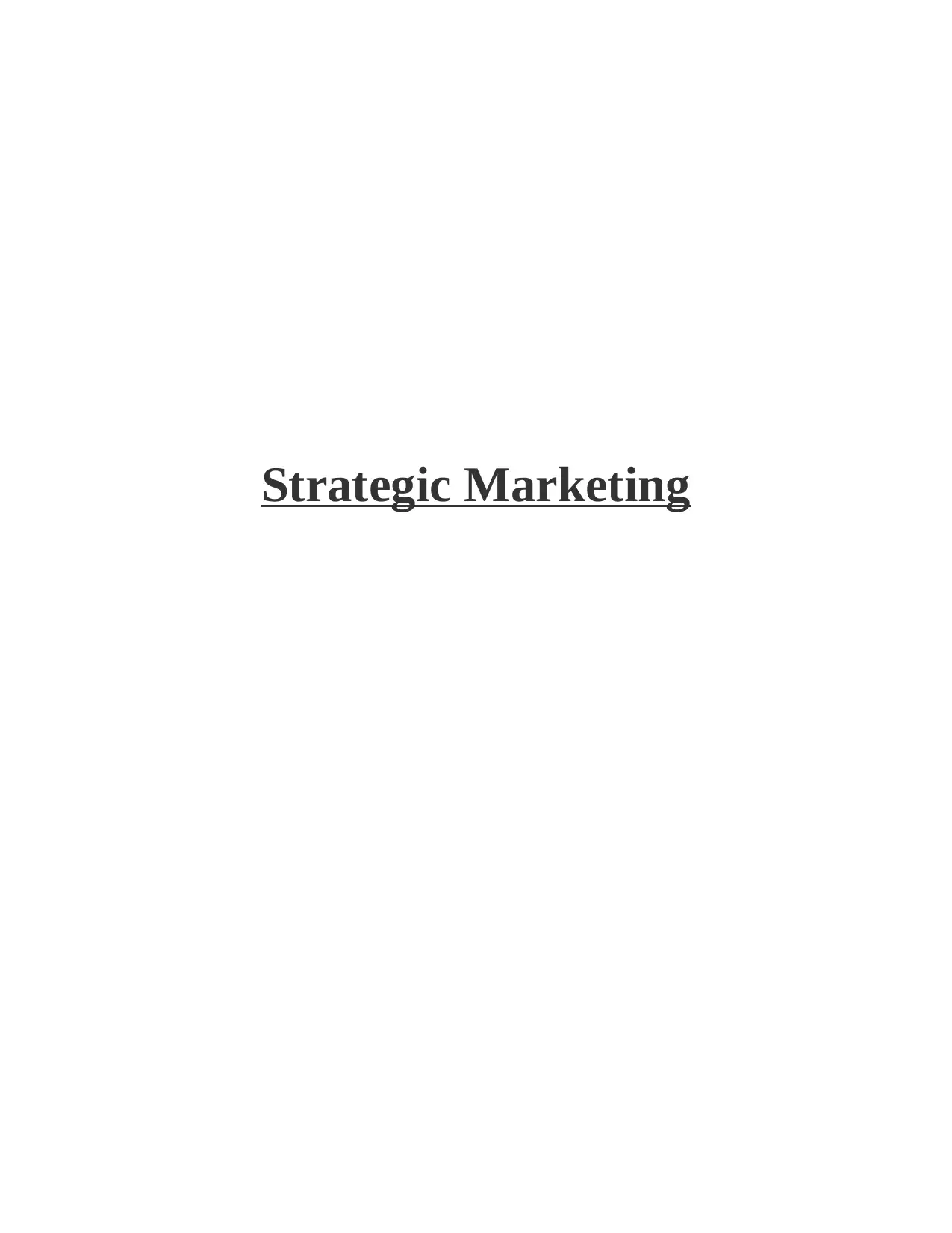
Strategic Marketing
Paraphrase This Document
Need a fresh take? Get an instant paraphrase of this document with our AI Paraphraser
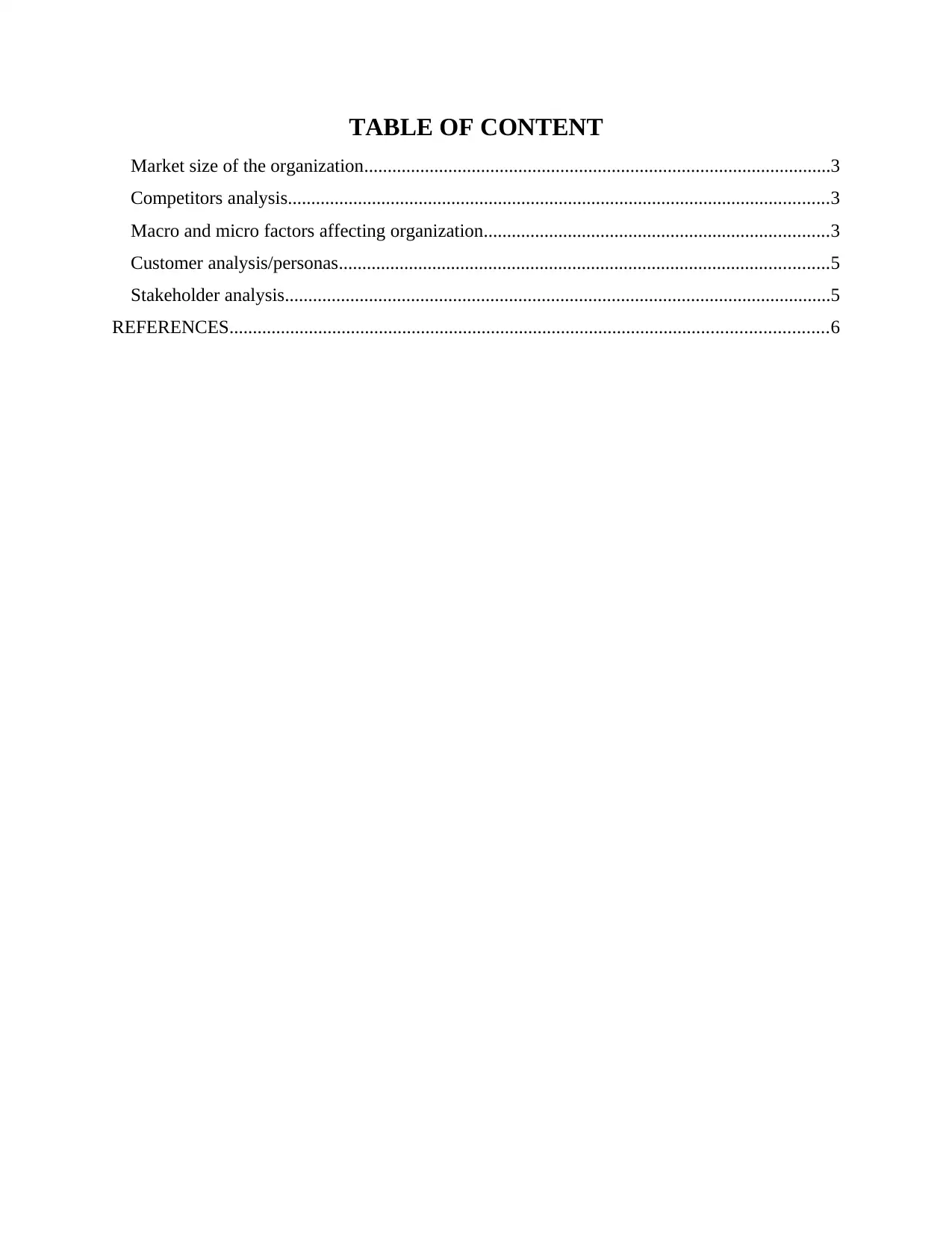
TABLE OF CONTENT
Market size of the organization....................................................................................................3
Competitors analysis....................................................................................................................3
Macro and micro factors affecting organization..........................................................................3
Customer analysis/personas.........................................................................................................5
Stakeholder analysis.....................................................................................................................5
REFERENCES................................................................................................................................6
Market size of the organization....................................................................................................3
Competitors analysis....................................................................................................................3
Macro and micro factors affecting organization..........................................................................3
Customer analysis/personas.........................................................................................................5
Stakeholder analysis.....................................................................................................................5
REFERENCES................................................................................................................................6
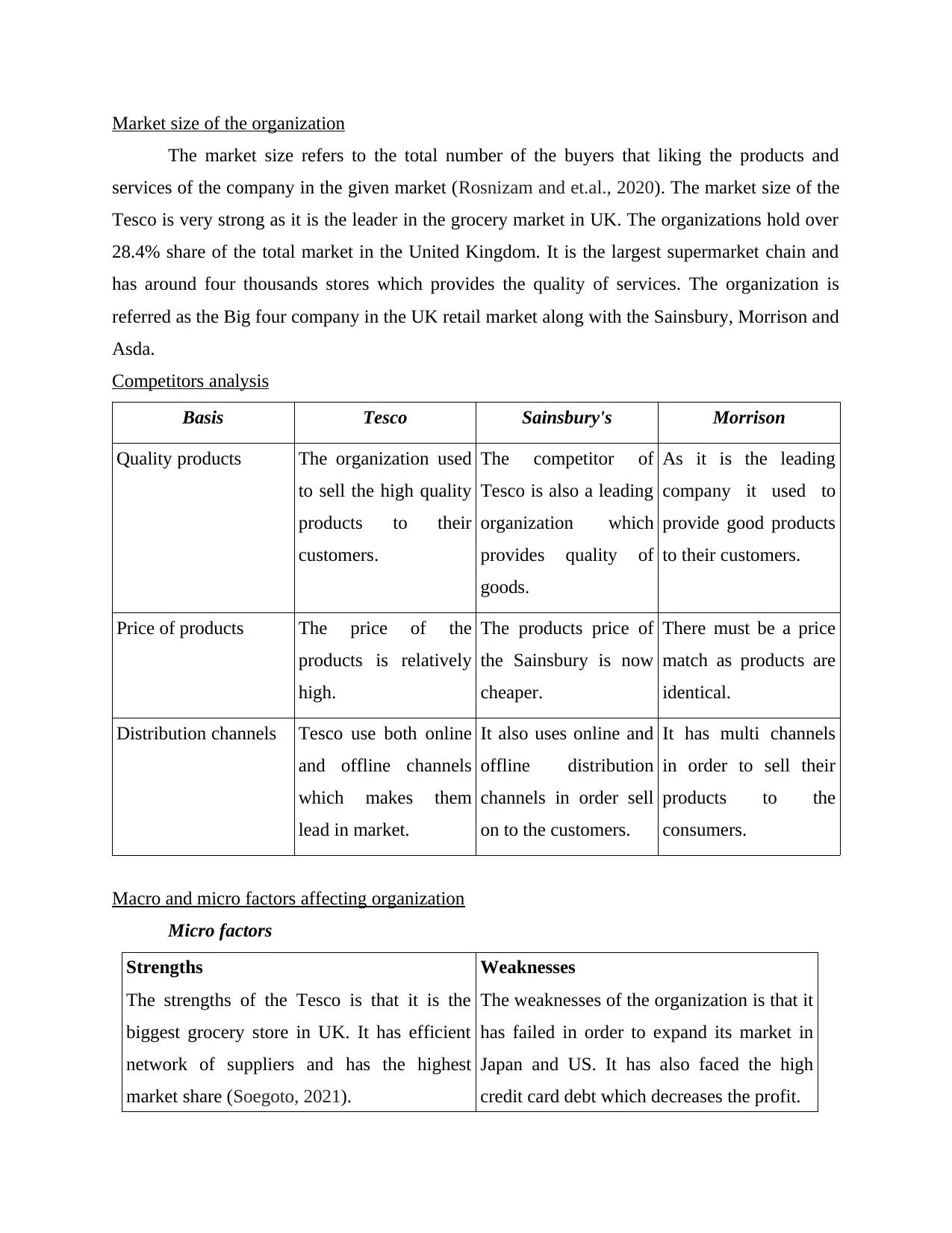
Market size of the organization
The market size refers to the total number of the buyers that liking the products and
services of the company in the given market (Rosnizam and et.al., 2020). The market size of the
Tesco is very strong as it is the leader in the grocery market in UK. The organizations hold over
28.4% share of the total market in the United Kingdom. It is the largest supermarket chain and
has around four thousands stores which provides the quality of services. The organization is
referred as the Big four company in the UK retail market along with the Sainsbury, Morrison and
Asda.
Competitors analysis
Basis Tesco Sainsbury's Morrison
Quality products The organization used
to sell the high quality
products to their
customers.
The competitor of
Tesco is also a leading
organization which
provides quality of
goods.
As it is the leading
company it used to
provide good products
to their customers.
Price of products The price of the
products is relatively
high.
The products price of
the Sainsbury is now
cheaper.
There must be a price
match as products are
identical.
Distribution channels Tesco use both online
and offline channels
which makes them
lead in market.
It also uses online and
offline distribution
channels in order sell
on to the customers.
It has multi channels
in order to sell their
products to the
consumers.
Macro and micro factors affecting organization
Micro factors
Strengths
The strengths of the Tesco is that it is the
biggest grocery store in UK. It has efficient
network of suppliers and has the highest
market share (Soegoto, 2021).
Weaknesses
The weaknesses of the organization is that it
has failed in order to expand its market in
Japan and US. It has also faced the high
credit card debt which decreases the profit.
The market size refers to the total number of the buyers that liking the products and
services of the company in the given market (Rosnizam and et.al., 2020). The market size of the
Tesco is very strong as it is the leader in the grocery market in UK. The organizations hold over
28.4% share of the total market in the United Kingdom. It is the largest supermarket chain and
has around four thousands stores which provides the quality of services. The organization is
referred as the Big four company in the UK retail market along with the Sainsbury, Morrison and
Asda.
Competitors analysis
Basis Tesco Sainsbury's Morrison
Quality products The organization used
to sell the high quality
products to their
customers.
The competitor of
Tesco is also a leading
organization which
provides quality of
goods.
As it is the leading
company it used to
provide good products
to their customers.
Price of products The price of the
products is relatively
high.
The products price of
the Sainsbury is now
cheaper.
There must be a price
match as products are
identical.
Distribution channels Tesco use both online
and offline channels
which makes them
lead in market.
It also uses online and
offline distribution
channels in order sell
on to the customers.
It has multi channels
in order to sell their
products to the
consumers.
Macro and micro factors affecting organization
Micro factors
Strengths
The strengths of the Tesco is that it is the
biggest grocery store in UK. It has efficient
network of suppliers and has the highest
market share (Soegoto, 2021).
Weaknesses
The weaknesses of the organization is that it
has failed in order to expand its market in
Japan and US. It has also faced the high
credit card debt which decreases the profit.
⊘ This is a preview!⊘
Do you want full access?
Subscribe today to unlock all pages.

Trusted by 1+ million students worldwide
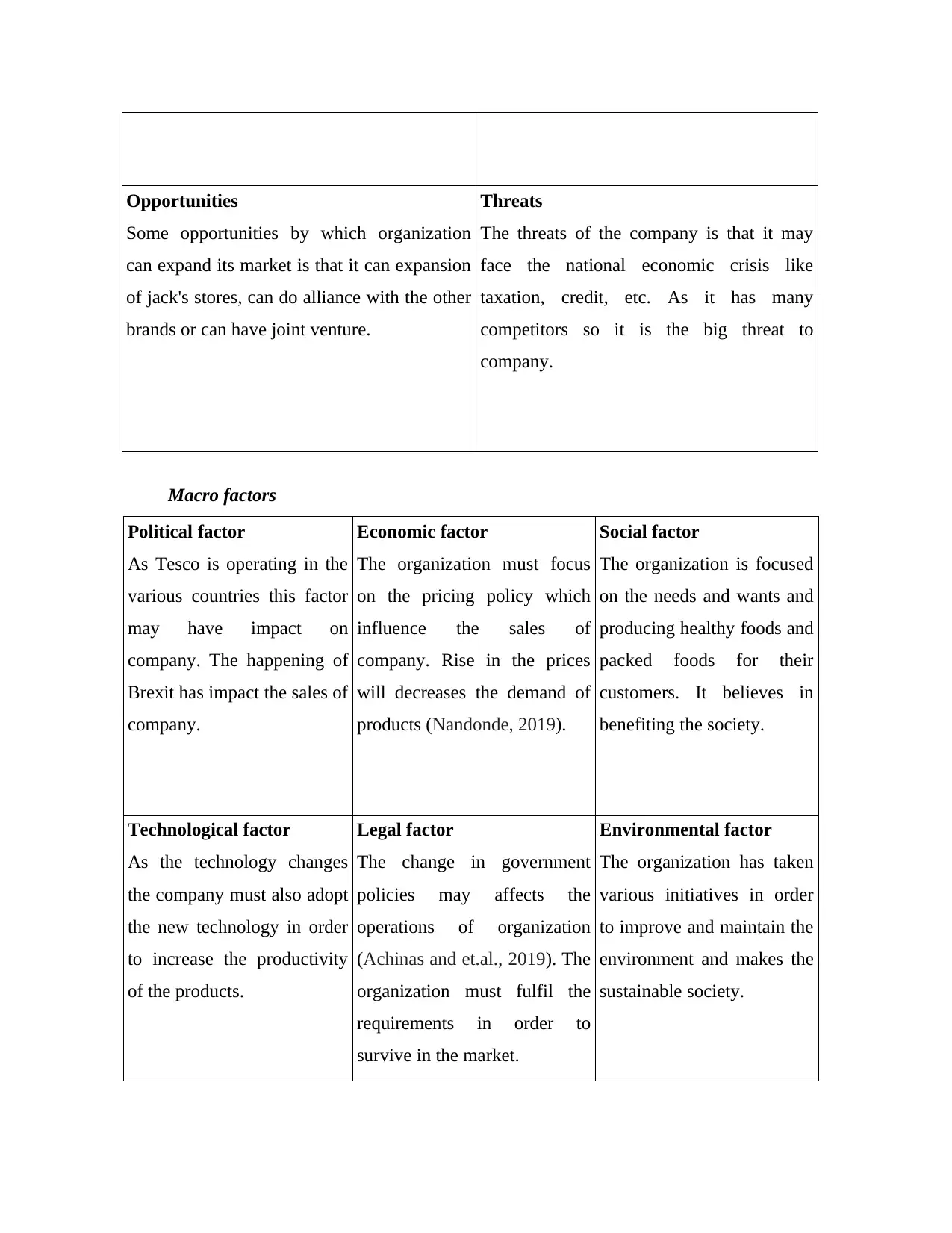
Opportunities
Some opportunities by which organization
can expand its market is that it can expansion
of jack's stores, can do alliance with the other
brands or can have joint venture.
Threats
The threats of the company is that it may
face the national economic crisis like
taxation, credit, etc. As it has many
competitors so it is the big threat to
company.
Macro factors
Political factor
As Tesco is operating in the
various countries this factor
may have impact on
company. The happening of
Brexit has impact the sales of
company.
Economic factor
The organization must focus
on the pricing policy which
influence the sales of
company. Rise in the prices
will decreases the demand of
products (Nandonde, 2019).
Social factor
The organization is focused
on the needs and wants and
producing healthy foods and
packed foods for their
customers. It believes in
benefiting the society.
Technological factor
As the technology changes
the company must also adopt
the new technology in order
to increase the productivity
of the products.
Legal factor
The change in government
policies may affects the
operations of organization
(Achinas and et.al., 2019). The
organization must fulfil the
requirements in order to
survive in the market.
Environmental factor
The organization has taken
various initiatives in order
to improve and maintain the
environment and makes the
sustainable society.
Some opportunities by which organization
can expand its market is that it can expansion
of jack's stores, can do alliance with the other
brands or can have joint venture.
Threats
The threats of the company is that it may
face the national economic crisis like
taxation, credit, etc. As it has many
competitors so it is the big threat to
company.
Macro factors
Political factor
As Tesco is operating in the
various countries this factor
may have impact on
company. The happening of
Brexit has impact the sales of
company.
Economic factor
The organization must focus
on the pricing policy which
influence the sales of
company. Rise in the prices
will decreases the demand of
products (Nandonde, 2019).
Social factor
The organization is focused
on the needs and wants and
producing healthy foods and
packed foods for their
customers. It believes in
benefiting the society.
Technological factor
As the technology changes
the company must also adopt
the new technology in order
to increase the productivity
of the products.
Legal factor
The change in government
policies may affects the
operations of organization
(Achinas and et.al., 2019). The
organization must fulfil the
requirements in order to
survive in the market.
Environmental factor
The organization has taken
various initiatives in order
to improve and maintain the
environment and makes the
sustainable society.
Paraphrase This Document
Need a fresh take? Get an instant paraphrase of this document with our AI Paraphraser
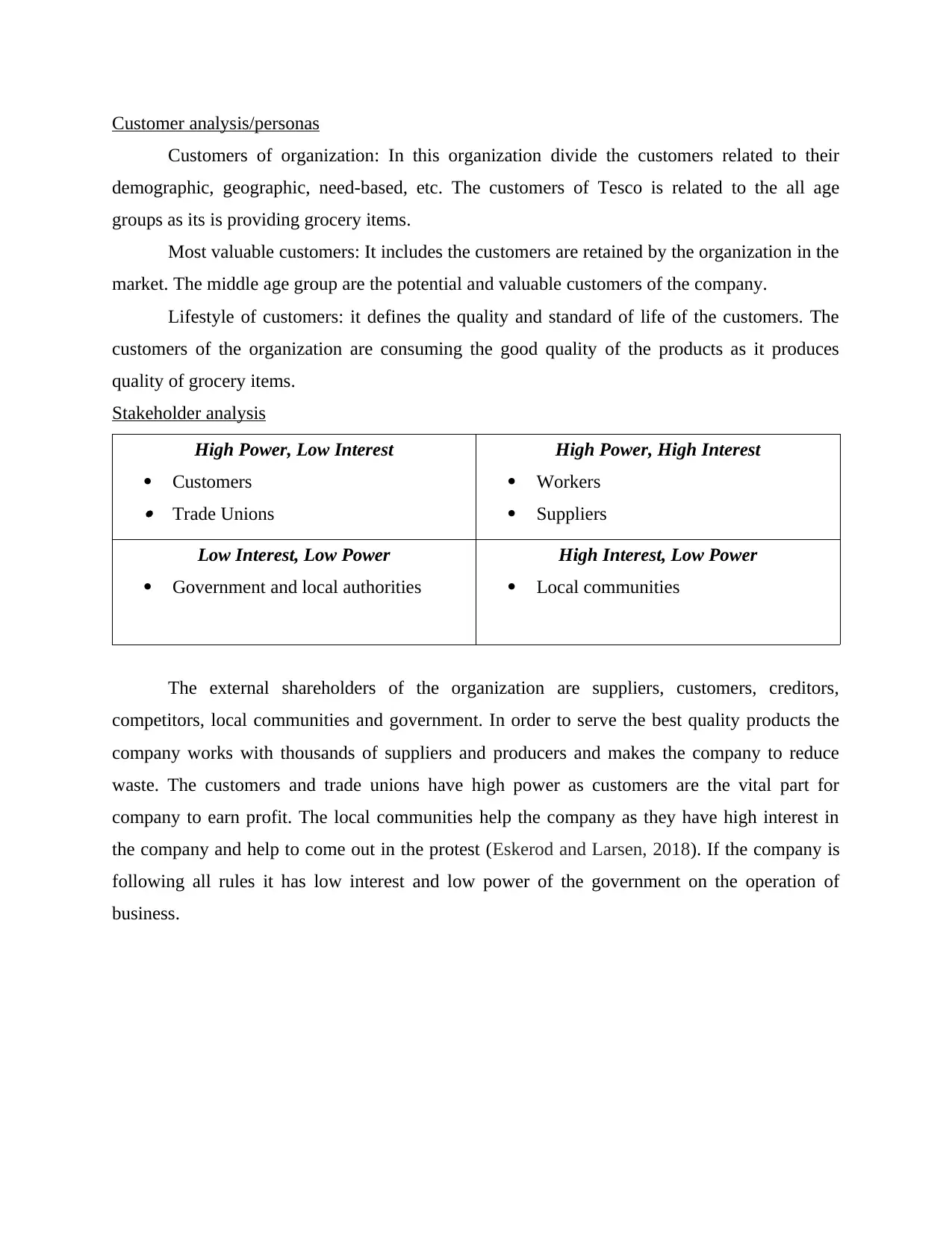
Customer analysis/personas
Customers of organization: In this organization divide the customers related to their
demographic, geographic, need-based, etc. The customers of Tesco is related to the all age
groups as its is providing grocery items.
Most valuable customers: It includes the customers are retained by the organization in the
market. The middle age group are the potential and valuable customers of the company.
Lifestyle of customers: it defines the quality and standard of life of the customers. The
customers of the organization are consuming the good quality of the products as it produces
quality of grocery items.
Stakeholder analysis
High Power, Low Interest
Customers Trade Unions
High Power, High Interest
Workers
Suppliers
Low Interest, Low Power
Government and local authorities
High Interest, Low Power
Local communities
The external shareholders of the organization are suppliers, customers, creditors,
competitors, local communities and government. In order to serve the best quality products the
company works with thousands of suppliers and producers and makes the company to reduce
waste. The customers and trade unions have high power as customers are the vital part for
company to earn profit. The local communities help the company as they have high interest in
the company and help to come out in the protest (Eskerod and Larsen, 2018). If the company is
following all rules it has low interest and low power of the government on the operation of
business.
Customers of organization: In this organization divide the customers related to their
demographic, geographic, need-based, etc. The customers of Tesco is related to the all age
groups as its is providing grocery items.
Most valuable customers: It includes the customers are retained by the organization in the
market. The middle age group are the potential and valuable customers of the company.
Lifestyle of customers: it defines the quality and standard of life of the customers. The
customers of the organization are consuming the good quality of the products as it produces
quality of grocery items.
Stakeholder analysis
High Power, Low Interest
Customers Trade Unions
High Power, High Interest
Workers
Suppliers
Low Interest, Low Power
Government and local authorities
High Interest, Low Power
Local communities
The external shareholders of the organization are suppliers, customers, creditors,
competitors, local communities and government. In order to serve the best quality products the
company works with thousands of suppliers and producers and makes the company to reduce
waste. The customers and trade unions have high power as customers are the vital part for
company to earn profit. The local communities help the company as they have high interest in
the company and help to come out in the protest (Eskerod and Larsen, 2018). If the company is
following all rules it has low interest and low power of the government on the operation of
business.
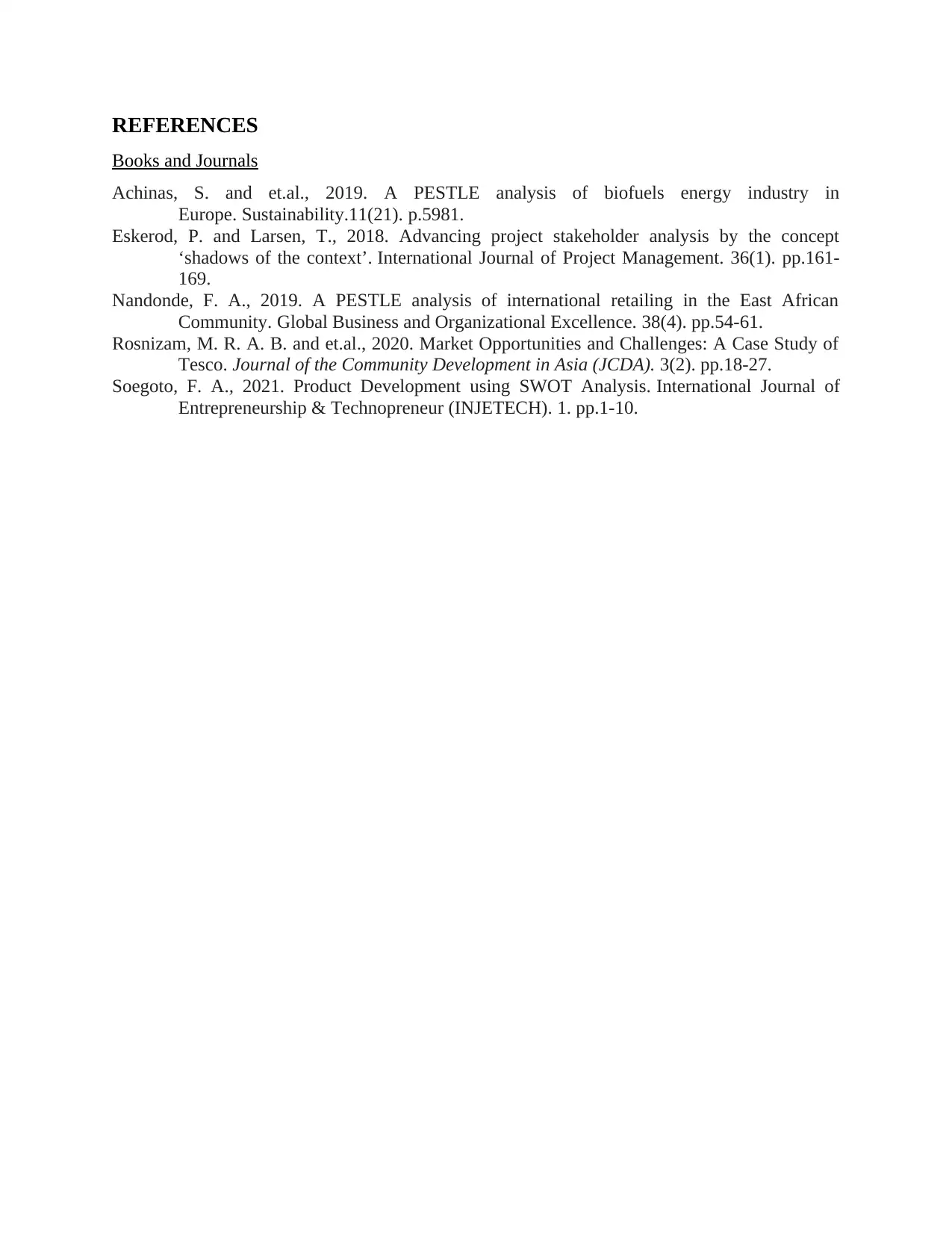
REFERENCES
Books and Journals
Achinas, S. and et.al., 2019. A PESTLE analysis of biofuels energy industry in
Europe. Sustainability.11(21). p.5981.
Eskerod, P. and Larsen, T., 2018. Advancing project stakeholder analysis by the concept
‘shadows of the context’. International Journal of Project Management. 36(1). pp.161-
169.
Nandonde, F. A., 2019. A PESTLE analysis of international retailing in the East African
Community. Global Business and Organizational Excellence. 38(4). pp.54-61.
Rosnizam, M. R. A. B. and et.al., 2020. Market Opportunities and Challenges: A Case Study of
Tesco. Journal of the Community Development in Asia (JCDA). 3(2). pp.18-27.
Soegoto, F. A., 2021. Product Development using SWOT Analysis. International Journal of
Entrepreneurship & Technopreneur (INJETECH). 1. pp.1-10.
Books and Journals
Achinas, S. and et.al., 2019. A PESTLE analysis of biofuels energy industry in
Europe. Sustainability.11(21). p.5981.
Eskerod, P. and Larsen, T., 2018. Advancing project stakeholder analysis by the concept
‘shadows of the context’. International Journal of Project Management. 36(1). pp.161-
169.
Nandonde, F. A., 2019. A PESTLE analysis of international retailing in the East African
Community. Global Business and Organizational Excellence. 38(4). pp.54-61.
Rosnizam, M. R. A. B. and et.al., 2020. Market Opportunities and Challenges: A Case Study of
Tesco. Journal of the Community Development in Asia (JCDA). 3(2). pp.18-27.
Soegoto, F. A., 2021. Product Development using SWOT Analysis. International Journal of
Entrepreneurship & Technopreneur (INJETECH). 1. pp.1-10.
⊘ This is a preview!⊘
Do you want full access?
Subscribe today to unlock all pages.

Trusted by 1+ million students worldwide
1 out of 6
Related Documents
Your All-in-One AI-Powered Toolkit for Academic Success.
+13062052269
info@desklib.com
Available 24*7 on WhatsApp / Email
![[object Object]](/_next/static/media/star-bottom.7253800d.svg)
Unlock your academic potential
Copyright © 2020–2025 A2Z Services. All Rights Reserved. Developed and managed by ZUCOL.



